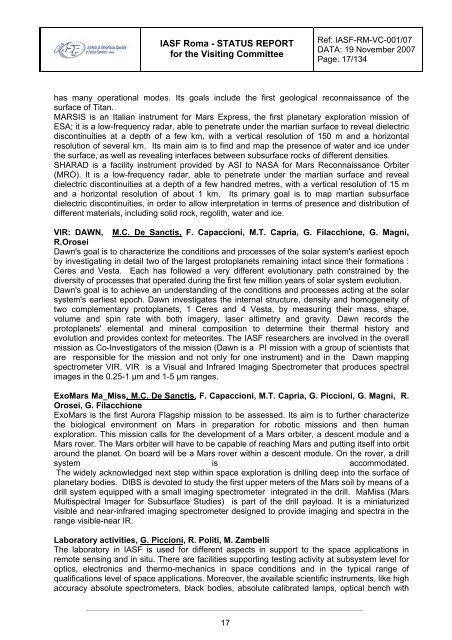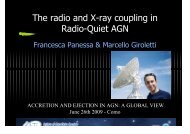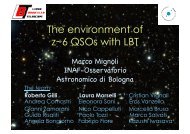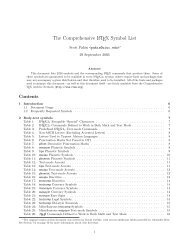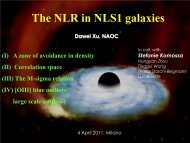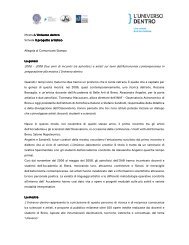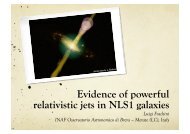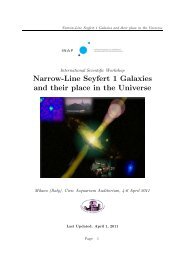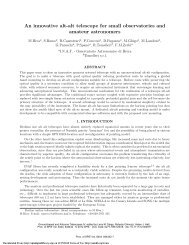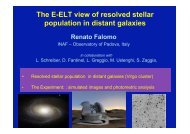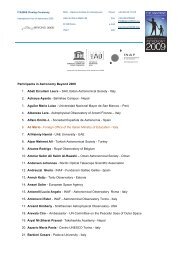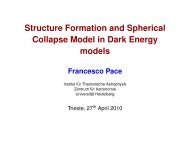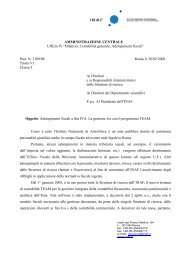IASFRome_StatusReport - INAF-IASF-Roma
IASFRome_StatusReport - INAF-IASF-Roma
IASFRome_StatusReport - INAF-IASF-Roma
You also want an ePaper? Increase the reach of your titles
YUMPU automatically turns print PDFs into web optimized ePapers that Google loves.
<strong>IASF</strong> <strong>Roma</strong> - STATUS REPORTfor the Visiting CommitteeRef: <strong>IASF</strong>-RM-VC-001/07DATA: 19 November 2007Page: 17/134has many operational modes. Its goals include the first geological reconnaissance of thesurface of Titan.MARSIS is an Italian instrument for Mars Express, the first planetary exploration mission ofESA; it is a low-frequency radar, able to penetrate under the martian surface to reveal dielectricdiscontinuities at a depth of a few km, with a vertical resolution of 150 m and a horizontalresolution of several km. Its main aim is to find and map the presence of water and ice underthe surface, as well as revealing interfaces between subsurface rocks of different densities.SHARAD is a facility instrument provided by ASI to NASA for Mars Reconnaissance Orbiter(MRO). It is a low-frequency radar, able to penetrate under the martian surface and revealdielectric discontinuities at a depth of a few handred metres, with a vertical resolution of 15 mand a horizontal resolution of about 1 km. Its primary goal is to map martian subsurfacedielectric discontinuities, in order to allow interpretation in terms of presence and distribution ofdifferent materials, including solid rock, regolith, water and ice.VIR: DAWN, M.C. De Sanctis, F. Capaccioni, M.T. Capria, G. Filacchione, G. Magni,R.OroseiDawn's goal is to characterize the conditions and processes of the solar system's earliest epochby investigating in detail two of the largest protoplanets remaining intact since their formations :Ceres and Vesta. Each has followed a very different evolutionary path constrained by thediversity of processes that operated during the first few million years of solar system evolution.Dawn's goal is to achieve an understanding of the conditions and processes acting at the solarsystem's earliest epoch. Dawn investigates the internal structure, density and homogeneity oftwo complementary protoplanets, 1 Ceres and 4 Vesta, by measuring their mass, shape,volume and spin rate with both imagery, laser altimetry and gravity. Dawn records theprotoplanets' elemental and mineral composition to determine their thermal history andevolution and provides context for meteorites. The <strong>IASF</strong> researchers are involved in the overallmission as Co-Investigators of the mission (Dawn is a PI mission with a group of scientists thatare responsible for the mission and not only for one instrument) and in the Dawn mappingspectrometer VIR. VIR is a Visual and Infrared Imaging Spectrometer that produces spectralimages in the 0.25-1 µm and 1-5 µm ranges.ExoMars Ma_Miss, M.C. De Sanctis, F. Capaccioni, M.T. Capria, G. Piccioni, G. Magni, R.Orosei, G. FilacchioneExoMars is the first Aurora Flagship mission to be assessed. Its aim is to further characterizethe biological environment on Mars in preparation for robotic missions and then humanexploration. This mission calls for the development of a Mars orbiter, a descent module and aMars rover. The Mars orbiter will have to be capable of reaching Mars and putting itself into orbitaround the planet. On board will be a Mars rover within a descent module. On the rover, a drillsystem is accommodated.The widely acknowledged next step within space exploration is drilling deep into the surface ofplanetary bodies. DIBS is devoted to study the first upper meters of the Mars soil by means of adrill system equipped with a small imaging spectrometer integrated in the drill. MaMiss (MarsMultispectral Imager for Subsurface Studies) is part of the drill payload. It is a miniaturizedvisible and near-infrared imaging spectrometer designed to provide imaging and spectra in therange visible-near IR.Laboratory activities, G. Piccioni, R. Politi, M. ZambelliThe laboratory in <strong>IASF</strong> is used for different aspects in support to the space applications inremote sensing and in situ. There are facilities supporting testing activity at subsystem level foroptics, electronics and thermo-mechanics in space conditions and in the typical range ofqualifications level of space applications. Moreover, the available scientific instruments, like highaccuracy absolute spectrometers, black bodies, absolute calibrated lamps, optical bench with17


